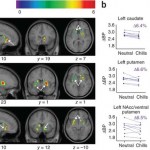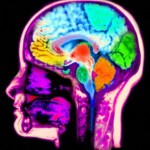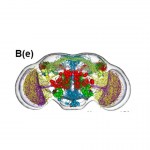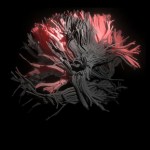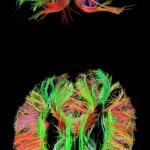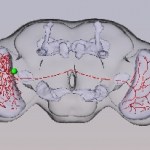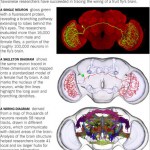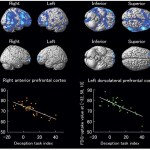Neurology
Figure 2: Evidence for dopamine release during pleasurable music listening.
Listening to music invokes our emotions, ranging from pleasure to disdain. It is one of our most human experiences, sometimes so profound that words cannot convey the intensity. One of my closest friends, a professor of musicology, once asked me in a moment of self doubt, "You're a scientist, you do important things...what good is music?" Like many creative souls, he had no idea how important the contribution of art is to our very being.
Canadian scientists have documented in a study published in Nature…
Last week, I shared an extraordinary study describing the human brain's "connectome" - our first glimpse into how neural connections are made in our brains. Recently, several studies have appeared attempting to link one's political views with our neuroanatomy - is this coincidence or somehow tied to the impending 2012 election cycle?
The most recent is a British study that purportes a link between political affiliations and the size of our amygdala...{hmmm....curious indeed...}
Fear and conservatism? I think we've all heard that before.
Researchers have found evidence that the brains of…
My previous postings on the fruit fly brain generated quite a bit of interest, and I wanted to share with you some more detail that I received from Terry C.-W. Yeh, researcher at the Applied Scientific Computing Division of the National Center for High-Performance Computing in Taiwan. Thank you, Terry, for being so gracious!
I hope you enjoy this decoded tour as much as I have.
Detail of 150 neurons.
Ever wonder about the distribution of neurotransmitters throughout the brain? {Recall my recent posting about dopamine receptors and liberalism - OK, there's no such thing as a "liberal" fly…
I have been exploring our "Brain's Atlas" introduced in my recent post and discovered an extraordinary resource: the Relationship Viewer. A snapshot is shown to the right, appearing as a spiraling multi-colored pin wheel.
This interactive viewer developed by the research group of Dr. Arthur W. Toga at the David Geffen UCLA School of Medicine Laboratory of Neuro Imaging (LONI) invites the user to explore:
Relationships in 2D brain, 3D brain and circular lines
As you explore the connections, the color scheme is:
Warmer colors mean stronger connections and cooler colors mean weaker…
If you thought the human genome project was impressive its scope and scale. think about the human connectome project.
I recently shared with you the fruit fly brain atlas, comprised of about 100,000 neurons, and compared it to the human brain with some 100 billion neurons.
The first high resolution images of the "connectedness" of the human brain are beginning to emerge:
According to the NIH-funded human connectome project, to be described in tomorrow's Science Times of The New York Times:
{My edits:}
Overview
Mapping of the human connectome offers a unique opportunity to understand the…
Inspired by my earlier posting on the fruit fly brain:
I received a nice "holiday gift" from a researcher at the National Center for High-Performance Computing (NCHC) in Taiwan, Terry C.-W. Yeh. NCHC and the Brain Research Center at the National Tsing Hua University created the FlyCircuit database.
This 32 second video gives you a 3D tour of the various components of the fruit fly brain integrating data collected using more than 16,000 individual neurons - a startling example, to me, of the wonderment of science as a product of bridging computer science, molecular biology and neuroscience…
My recent posting, The Fruit Fly Brain Atlas Emerges generated quite a bit of interest from readers, perhaps because most of us are visual learners, including myself. One reader's comment reminded me how fun it was to explore the FlyCircuit database. It's easy to register; once you're in, you can not only browse the more than 16,000 neurons (I know...) but you can view 3D movies. I invite readers to send me via email your favorite image or movie, and why, and I'll post a future article compiling them. I think this will be fun!
As reported in today's Science Times of The New York Times, a research group in Taiwan led by Dr. Ann-Shyn Chiang has accomplished something that was unimaginable when I was a graduate student in the 1980's: they have created the first atlas of the brain of a fruit fly at the resolution of a single neuron! Using cloning techniques and a protein that appears green under certain conditions, they have created three dimensional images of neurons one at a time from a large collection of fruit fly brains and merged the images into a single "atlas".
Some quick facts:
The fruit fly has about 100,…
THE daguerreotype on the right is believed to be the only known image of railroad worker Phineas Gage, who was enshrined in the history of neuroscience one day in September, 1848, when a large iron rod he was using to tamp gunpowder into a hole in a rock caused an explosion and was propelled through his brain.
The photograph, which shows Gage holding the tamping iron, has been in the possession of photograph collectors Jack and Beverley Wilgus of Massachusetts for 30 years. They had believed it was of a whaler with his harpoon, but someone suggested it might in fact be Gage after it was…
Speaking of the debate over patents interfering with medical care, there's a story in today's New York Times that mentions the drug Iplex, which has shown promise for treating Lou Gehrig's disease -- a deadly and thus far untreatable degenerative disease (also known as amyotrophic lateral sclerosis).
From the article:
Iplex ... is believed to protect the motor neurons whose
death leads to paralysis in A.L.S. Some patients had persuaded their
doctors to prescribe the drug when the F.D.A. approved it in late 2006
for children with growth deficiencies. "I started on Tuesday," Debbie…
Neurological diseases can be strange in that they often have additional personality effects. If someone gets a cold, they sneeze a bunch but are basically the same person they were before the cold. In contrast, meningitis can include mental status and personality changes in its early stages -- including irritability and sleepiness. When a disease involves the brain, it can change who we are in addition to making us sick.
In this vein, I found this paper in the journal Brain particularly interesting. Abe et al. report that Parkinson's patients tell fewer lies than controls in a task where…
Seed Magazine has a nice review of the brewing controversy over shoddy statistical methods in the field of fMRI. To some extent science is politics, this is a sexy and appealing field. A friend of mine who is a psychologist mentioned that though he doesn't think much of fMRI the head of his lab group wanted to make sure that there was always some neural imaging in their papers to increase the likelihood of acceptance. A few vivid images is worth a lot of turgid prose; even if some of the criticisms of fMRI are overblown I suspect that it was necessary that the field be brought down a few…
In this Sunday's Washington Post, I reviewed Hannah Holmes's book The Well-Dressed Ape. Overall it was a pretty positive review, but I criticized her for the way she linked testosterone (via left-handedness and ring-finger length) with various traits, including violence, autism, homosexuality, etc (see review for details). So I was very interested to see this great post on Neuroskeptic today about the problems with coverage of testosterone (pictured left) and autism. Check it out.
I'm speaking at the ScienceOnline09 Conference in Durham, NC, today so I have little time to post, but I wanted to throw up this fun thing from the Boston Globe to keep everyone occupied while I'm away:
"DO YOU EVER want to change the way you see the world? Wouldn't it be fun to hallucinate on
your lunch break? Although we typically associate such phenomena with powerful drugs
like LSD or mescaline, it's easy to fling open the doors of perception without them: All it
takes is a basic understanding of how the mind works."
Try for yourself here. I particularly like the rubber hand trick…
Right about now, many people are starting to fail at their New Year's resolutions. It happens every year: You were good for a couple weeks, but right about now you're starting to slip with a few cookies, some skipped days at the gym ... Why? Because humans aren't very good at changing, which involves nothing short of rewiring our brains.
A while ago I wrote a story for O, The Oprah Magazine, called "Why is it So Damn Hard to Change," which looks at the neurology of why most New Years resolutions fail, and the ways understanding a bit of science can help people struggling to break old…
A group of psychologists, ethicists and neuroscientists have added their voices to the growing debate over the merits and demerits of brain droping, the use of cognitive enhancement drugs like Adderall or Ritalin to improve mental performance. Their commentary, published online Sunday in Nature, argues that any adult in full mental health should be able to use the drugs at will. "Given the many cognitive-enhancing tools we accept already, from writing to laptop computers," they ask, "why draw the line here and say, thus far but no further?"
